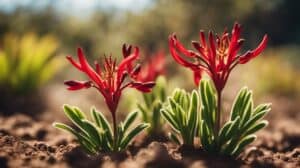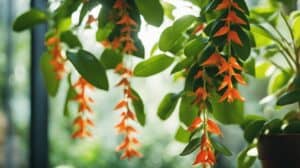Panama Queen, scientifically known as Aphelandra Sinclairiana, is a tropical plant that is native to the rainforests of Central and South America.
It is a popular houseplant due to its striking appearance and easy care requirements.
The plant has broad, glossy, green leaves that are accented with bright yellow veins and spikes of yellow flowers.

One of the most interesting aspects of Panama Queen is its propagation process. Unlike many other houseplants, Panama Queen can be propagated from cuttings.
This means that new plants can be grown from a section of the original plant, making it an affordable and sustainable way to expand your collection.
In this article, we will explore the best methods for cultivating Panama Queen cuttings and ensuring their success.
Whether you are a seasoned plant parent or a beginner, this guide will provide you with the information you need to propagate and care for your own Panama Queen plants.
Understanding Aphelandra Sinclairiana
Aphelandra Sinclairiana, also known as the Panama Queen, is a beautiful tropical plant that is native to Central and South America.
It is a member of the Acanthaceae family and is highly prized for its striking foliage and stunning flowers.
The leaves of the Aphelandra Sinclairiana are large, glossy, and deep green in color. They are ovate in shape and have a slightly wavy edge.
The most distinctive feature of this plant is its flowers, which are bright yellow and resemble a crown.
The flowers bloom in the summer and can last for several weeks.
In order to cultivate the Panama Queen, it is important to understand its growing requirements.
This plant thrives in warm, humid environments and prefers bright, indirect light.
It is important to keep the soil moist but not waterlogged, as too much water can lead to root rot.
Propagation of the Aphelandra Sinclairiana is best achieved through stem cuttings.
The cuttings should be taken from the tip of the stem and should be approximately 4-6 inches in length.
The cuttings should be dipped in rooting hormone and placed in a well-draining soil mix.
It is important to keep the soil moist and to provide the cuttings with bright, indirect light.
Overall, the Aphelandra Sinclairiana is a beautiful and unique plant that can make a stunning addition to any indoor garden.
With proper care and attention, it can thrive and provide years of enjoyment.
Propagation Techniques

Panama Queen (Aphelandra Sinclairiana) can be propagated through stem cuttings, seed germination, and layering.
Stem Cuttings
Stem cuttings can be taken from the Panama Queen plant during the growing season.
The best time to take cuttings is in the spring or summer when the plant is actively growing.
Cuttings should be taken from the tips of the stems and should be about 4-6 inches long. Remove the lower leaves and dip the cut end in rooting hormone.
Then, plant the cutting in a well-draining soil mix and keep it moist. The cutting should root in about 4-6 weeks.
Seed Germination
Panama Queen can also be propagated from seeds. The seeds should be sown in a well-draining soil mix and kept moist.
The seeds should germinate in about 2-3 weeks. Once the seedlings have grown to a few inches tall, they can be transplanted to their permanent location.
Layering
Layering is another method of propagating the Panama Queen plant. This method involves bending a stem down to the ground and covering it with soil.
The stem should be wounded where it touches the soil to encourage rooting.
Once the stem has rooted, it can be cut from the parent plant and transplanted to its permanent location.
Overall, Panama Queen propagation is a simple process that can be done through stem cuttings, seed germination, or layering.
With proper care and attention, new plants can be grown easily from the parent plant.
Caring for New Plants

Growing Panama Queen plants from cuttings is an easy and effective way to propagate the species.
Once the cutting has rooted and new growth has emerged, it is time to start caring for the new plant.
Soil Requirements
Aphelandra Sinclairiana prefers well-draining soil that is rich in organic matter. A mixture of peat moss, perlite, and vermiculite works well for the plant.
It is important to ensure that the soil is moist but not waterlogged, as this can lead to root rot.
Watering and Feeding
The key to keeping Panama Queen plants healthy is to provide them with consistent moisture. Water the plant when the top inch of soil feels dry to the touch.
During the growing season, fertilize the plant every two weeks with a balanced liquid fertilizer.
Be sure to follow the instructions on the fertilizer package carefully to avoid over-fertilizing.
Light and Temperature Conditions
Panama Queen plants require bright, indirect light to thrive. They can tolerate some direct sunlight, but too much can scorch the leaves.
It is important to keep the plant away from cold drafts and sudden temperature changes, as this can cause stress to the plant.
By following these simple care instructions, growers can ensure that their new Panama Queen plants thrive and flourish.
With proper care, these beautiful plants can provide years of enjoyment and make a stunning addition to any home or garden.
Frequently Asked Questions

How do you propagate Aphelandra Sinclairiana from cuttings?
Propagating Aphelandra Sinclairiana from cuttings is relatively easy.
Take a cutting from a healthy stem, making sure it has at least two leaves. Remove the lower leaves and dip the end of the cutting in rooting hormone.
Plant the cutting in well-draining soil, keep it moist, and place it in a warm and bright location.
In a few weeks, roots should start to form, and a new plant will begin to grow.
What are the optimal soil conditions for growing Panama Queen plants?
Panama Queen plants prefer well-draining soil that is rich in organic matter. A mix of peat moss, perlite, and vermiculite is ideal.
The soil should be kept moist but not waterlogged, as this can lead to root rot.
How often should I water my Aphelandra Sinclairiana?
Aphelandra Sinclairiana should be watered when the top inch of soil feels dry. Water thoroughly, allowing excess water to drain away.
Avoid letting the plant sit in standing water, as this can cause root rot.
What is the best lighting setup for a healthy Panama Queen plant?
Panama Queen plants require bright, indirect light to thrive.
They should be placed near a window that receives filtered sunlight or under artificial grow lights.
Avoid placing them in direct sunlight, as this can scorch the leaves.
Can Aphelandra Sinclairiana be grown indoors, and if so, how?
Yes, Aphelandra Sinclairiana can be grown indoors.
They prefer warm and humid conditions, so it’s best to place them in a bright location near a window or under artificial grow lights.
Keep the soil moist and mist the leaves regularly to increase humidity.
What are common pests or diseases that affect the Panama Queen plant, and how can they be treated?
Panama Queen plants are susceptible to spider mites, mealybugs, and scale insects.
To treat an infestation, isolate the affected plant and spray it with insecticidal soap or neem oil.
Avoid overwatering, as this can lead to root rot and other fungal diseases.













